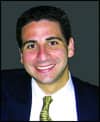by Mark E. Berkman, DDS, MS

What, if anything, will be the “next big thing” in orthodontics? The answer lies in science and research. Many basic scientists and clinical researchers are advancing the frontiers of our knowledge of medicine, materials, disease, and biology. Because of those involved in science and research at the molecular biological level, the methods employed by our specialty will soon be forever changed.
In the past 10 years, arguably the biggest developments in clinical orthodontics stem from the more widespread use of osseointegrated implants, first discovered by an orthopedic surgeon, Per Ing Var Branemark, MD. Anchorage concerns are a part of nearly every orthodontic case, and implant-assisted orthodontics has made possible the correction of malocclusions that previously would have been unsurmountable. Recently, mini-implants have usurped osseointegrated implants in popularity. Mini-implants, which may be placed in alveolar bone just about anywhere there isn’t a root or a nerve, have made implant-assisted tooth-movement procedures more convenient and predictable.
But is there an alternative to implant placement when a maximum anchorage requirement exists? Our colleagues in medicine, particularly those who treat osseous diseases including osteoporosis, will tell us that there may indeed be! Osteoporosis, after all, is the progressive loss of bone density, a process mediated largely by osteoclasts—the same cells that are active in removing bone as teeth move through bone orthodontically. We all remember the histology: osteoclasts remove the bone on the compression side of the PDL, and osteoblasts lay down new bone on the tension side.
Osteoclasts play the primary role in bone resorption, and bone resorption is a primary biological phenomenon that allows tooth movement. So if the goal is orthodontic anchorage (resistance to tooth movement), it seems reasonable that if we throw a pharmacological wrench into the mix that affects osteoclasts, the downstream effect will be a restriction on tooth movement. And voila! Anchorage without screws.
Currently, two major classifications of drugs show promise. The first are the bisphosphonates, which may be taken orally or intravenously, and which have a high affinity for bone tissue. Bisphosphonates are already big players in the treatment of many bone-related systemic diseases.
Do they work? Yes. But a major problem is osteonecrosis, and interestingly, jaw bone is especially susceptible. Osteoclast action is very important to bone metabolism generally, and potent bisphosphonates that kill osteoclasts in great numbers sometimes create this side effect.
The second major classification (that so far shows greater promise) is an osteoclastogenesis inhibitory factor. Osteoprotegrin (OPG), a naturally occurring protein, was first identified in 1997. Unlike the bisphosphonates, which kill already-functioning osteoclasts, OPG is a “decoy molecule” that binds selectively to certain factors that, if left alone, would induce osteoclast formation.
The results of a study in orthodontics, one that investigated tooth movement in rats who underwent gingival injections of OPG, was presented during the poster session of the 2006 AAO in Las Vegas. Even newer research is under way, and thanks to our colleagues in the basic biological sciences, OPG and other osteoclastogenesis-inhibitory factors are slated to be one of the “next big things” in orthodontics.
I have little doubt that pharmacological agents to increase anchorage will eventually be widely used, and the use of implants to facilitate our biomechanical needs will become less and less favored. At some point in the future, to prevent the unwanted occlusal effects of equal and opposite reactions, orthodontists will simply pick up a soft-tipped syringe and deliver small microspheres of anchorage-promoting agents directly into a tooth sulcus: a controlled, targeted delivery of pharmacological anchorage, which starts exactly when desired, lasts as long as needed, and is eventually biologically eliminated.
The genomic era is upon us. As we and our colleagues in medicine come to understand these developments and and translate them into a host of new technologies, we will be afforded opportunities to dazzle our patients by rendering increasingly effective care in ever more comfortable and predictable ways. I’m excited about it! z
Mark E. Berkman, DDS, MS, maintains a private practice in Commerce Township, Mich, and is an adjunct assistant professor at the University of Michigan. He is a director of the Michigan Association of Orthodontists and a Vanguard member of the AAOF. He can be reached at [email protected].









